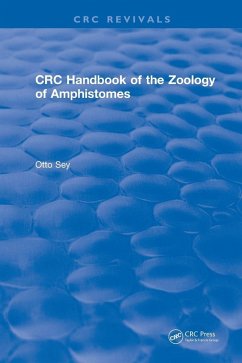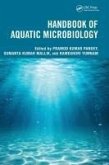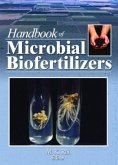Otto Sey
CRC Handbook of the Zoology of Amphistomes
Otto Sey
CRC Handbook of the Zoology of Amphistomes
- Gebundenes Buch
- Merkliste
- Auf die Merkliste
- Bewerten Bewerten
- Teilen
- Produkt teilen
- Produkterinnerung
- Produkterinnerung
Handbook of the Zoology of Amphistomes provides a comprehensive survey on the morphology, ecology, systematics, and zoogeography of amphistomes, which are a group of digenetic trematodes parasitic in vertebrates.
Andere Kunden interessierten sich auch für
![Handbook of Corynebacterium glutamicum Handbook of Corynebacterium glutamicum]() Lothar Eggeling / Michael Bott (eds.)Handbook of Corynebacterium glutamicum406,99 €
Lothar Eggeling / Michael Bott (eds.)Handbook of Corynebacterium glutamicum406,99 €![Exploring the Blue Bioeconomy Exploring the Blue Bioeconomy]() Sanjeewa KkaExploring the Blue Bioeconomy109,99 €
Sanjeewa KkaExploring the Blue Bioeconomy109,99 €![Handbook of Aquatic Microbiology Handbook of Aquatic Microbiology]() Handbook of Aquatic Microbiology200,99 €
Handbook of Aquatic Microbiology200,99 €![Handbook of Microbial Biofertilizers Handbook of Microbial Biofertilizers]() Handbook of Microbial Biofertilizers261,99 €
Handbook of Microbial Biofertilizers261,99 €![Handbook of Microbial Iron Chelates (1991) Handbook of Microbial Iron Chelates (1991)]() Gunther WinkelmannHandbook of Microbial Iron Chelates (1991)300,99 €
Gunther WinkelmannHandbook of Microbial Iron Chelates (1991)300,99 €![Antimicrobial Resistance of the Human Eye Antimicrobial Resistance of the Human Eye]() Antimicrobial Resistance of the Human Eye304,99 €
Antimicrobial Resistance of the Human Eye304,99 €![Cleanroom Microbiology for the Non-Microbiologist Cleanroom Microbiology for the Non-Microbiologist]() David M. CarlbergCleanroom Microbiology for the Non-Microbiologist324,99 €
David M. CarlbergCleanroom Microbiology for the Non-Microbiologist324,99 €-
-
-
Handbook of the Zoology of Amphistomes provides a comprehensive survey on the morphology, ecology, systematics, and zoogeography of amphistomes, which are a group of digenetic trematodes parasitic in vertebrates.
Hinweis: Dieser Artikel kann nur an eine deutsche Lieferadresse ausgeliefert werden.
Hinweis: Dieser Artikel kann nur an eine deutsche Lieferadresse ausgeliefert werden.
Produktdetails
- Produktdetails
- Verlag: CRC Press
- Seitenzahl: 490
- Erscheinungstermin: 27. Juli 2017
- Englisch
- Abmessung: 260mm x 183mm x 31mm
- Gewicht: 1108g
- ISBN-13: 9781138105430
- ISBN-10: 1138105430
- Artikelnr.: 49438143
- Herstellerkennzeichnung
- Libri GmbH
- Europaallee 1
- 36244 Bad Hersfeld
- gpsr@libri.de
- Verlag: CRC Press
- Seitenzahl: 490
- Erscheinungstermin: 27. Juli 2017
- Englisch
- Abmessung: 260mm x 183mm x 31mm
- Gewicht: 1108g
- ISBN-13: 9781138105430
- ISBN-10: 1138105430
- Artikelnr.: 49438143
- Herstellerkennzeichnung
- Libri GmbH
- Europaallee 1
- 36244 Bad Hersfeld
- gpsr@libri.de
Otto Sey
1. Morphology of the Amphistomes 2. Designation and Scope of Amphistomes 3.
Techniques for Studies of Adult Amphistomes 4. General Appearance of the
Amphistomes 5. Body Shape and Size 6. Body Surface 7. Tegumental Papillae
8. Organ Systems 9. Digestive System 10. Reproductive System 11. Male
Genital Organs 12. Female Genital Organs 13. Excretory System 14. Lymphatic
System 15. Nervous System 16. Histo-Morphology of the Muscular Organs 17.
Pharynx and Keys to Their Types 18. Types of the Pharynx with Two
Intramural Primary Pharyngeal Sacs 19. Types of the Pharynx with Two
Extramural Primary Pharyngeal Sacs 21. Type of the Pharynx with Unpaired
Primary Pharyngeal Sac 22. Types of the Pharynx with Pharyngeal Bulb and
Secondary Pharyngeal Sacs 23. Types of Pharynx without Pharyngeal Bulb and
Secondary Pharyngeal Sacs 24. Terminal Genitalium and Keys to Their Types
25. Types of the Terminal Genitalium with True Or Modified Cirrus-Sac 26.
Types of the Terminal Genitalium with Hermaphroditic Pouch 27. Types of the
Terminal Genitalium without Cirrus-Sac and Hermaphroditic Pouch and with
Tegumental Papillae 28. Types of the Terminal Genitalium without
Cirrus-Sac, Hermaphroditic Pouch and Tegumental Papillae 29. Acetabulum and
Keys to Their Types 30. Acetabulum of the Group I 31. Types of the
Acetabulum of Group I 32. Acetabulum of the Group II 33. Types of the
Acetabulum of Group II 34. Acetabulum of the Group III 35. Types of the
Acetabulum of the Group III 36. Ecology of the Amphistomes 37. Life-History
Pattern 38. Pre-Parasitic Stage 39. Intramolluscan Larval Stage 40.
Sporocyst 41. Redia 42. Cercaria, Adolescaria 43. Life-Cycle in the
Definitive Hosts 44. Intermediate Snail Hosts and Intermediate
Host-Specificity 45. Scope of the Definitive Hosts and the Host-Specificity
46. Effects of the Worm-Burden on Definitive Hosts 47. Systematics of the
Amphistomes 48. History of the Classification 49. Order Amphistomida 50.
Heronimata 51. Zonocotylata 52. Paramphistomata 53. Cladorchoidea 54.
Cladorchiidae 55. Diplodiscidae 56. Gastrodiscidae 57. Balanorchiidae 58.
Brumptiidae 59. Paramphistomoidea 60. Zygocotylidae 61. Gastrothylacidae
62. Paramphistomidae 63. Orthocoeliinae 64. Paramphistominae 65.
Phylogenetic Relationships Among Amphistomes 66. Zoogeography of the
Amphistomes 67. General Accounts 68. Co-Evolutionary Relationships 69.
Distribution and Characterization of Amphistomes by Zoogeographical Realism
70. Palaearctic Realm 71. Nearctic Realm 72. Neotropical Realm 73.
Africotropical Realm 74. Indomalyan Realm 75. Australian and Oceanic Realms
76. Dynamic Zoogeography of the Amphistomes 77. Evolution of Amphistomes
78. References.
Techniques for Studies of Adult Amphistomes 4. General Appearance of the
Amphistomes 5. Body Shape and Size 6. Body Surface 7. Tegumental Papillae
8. Organ Systems 9. Digestive System 10. Reproductive System 11. Male
Genital Organs 12. Female Genital Organs 13. Excretory System 14. Lymphatic
System 15. Nervous System 16. Histo-Morphology of the Muscular Organs 17.
Pharynx and Keys to Their Types 18. Types of the Pharynx with Two
Intramural Primary Pharyngeal Sacs 19. Types of the Pharynx with Two
Extramural Primary Pharyngeal Sacs 21. Type of the Pharynx with Unpaired
Primary Pharyngeal Sac 22. Types of the Pharynx with Pharyngeal Bulb and
Secondary Pharyngeal Sacs 23. Types of Pharynx without Pharyngeal Bulb and
Secondary Pharyngeal Sacs 24. Terminal Genitalium and Keys to Their Types
25. Types of the Terminal Genitalium with True Or Modified Cirrus-Sac 26.
Types of the Terminal Genitalium with Hermaphroditic Pouch 27. Types of the
Terminal Genitalium without Cirrus-Sac and Hermaphroditic Pouch and with
Tegumental Papillae 28. Types of the Terminal Genitalium without
Cirrus-Sac, Hermaphroditic Pouch and Tegumental Papillae 29. Acetabulum and
Keys to Their Types 30. Acetabulum of the Group I 31. Types of the
Acetabulum of Group I 32. Acetabulum of the Group II 33. Types of the
Acetabulum of Group II 34. Acetabulum of the Group III 35. Types of the
Acetabulum of the Group III 36. Ecology of the Amphistomes 37. Life-History
Pattern 38. Pre-Parasitic Stage 39. Intramolluscan Larval Stage 40.
Sporocyst 41. Redia 42. Cercaria, Adolescaria 43. Life-Cycle in the
Definitive Hosts 44. Intermediate Snail Hosts and Intermediate
Host-Specificity 45. Scope of the Definitive Hosts and the Host-Specificity
46. Effects of the Worm-Burden on Definitive Hosts 47. Systematics of the
Amphistomes 48. History of the Classification 49. Order Amphistomida 50.
Heronimata 51. Zonocotylata 52. Paramphistomata 53. Cladorchoidea 54.
Cladorchiidae 55. Diplodiscidae 56. Gastrodiscidae 57. Balanorchiidae 58.
Brumptiidae 59. Paramphistomoidea 60. Zygocotylidae 61. Gastrothylacidae
62. Paramphistomidae 63. Orthocoeliinae 64. Paramphistominae 65.
Phylogenetic Relationships Among Amphistomes 66. Zoogeography of the
Amphistomes 67. General Accounts 68. Co-Evolutionary Relationships 69.
Distribution and Characterization of Amphistomes by Zoogeographical Realism
70. Palaearctic Realm 71. Nearctic Realm 72. Neotropical Realm 73.
Africotropical Realm 74. Indomalyan Realm 75. Australian and Oceanic Realms
76. Dynamic Zoogeography of the Amphistomes 77. Evolution of Amphistomes
78. References.
1. Morphology of the Amphistomes 2. Designation and Scope of Amphistomes 3.
Techniques for Studies of Adult Amphistomes 4. General Appearance of the
Amphistomes 5. Body Shape and Size 6. Body Surface 7. Tegumental Papillae
8. Organ Systems 9. Digestive System 10. Reproductive System 11. Male
Genital Organs 12. Female Genital Organs 13. Excretory System 14. Lymphatic
System 15. Nervous System 16. Histo-Morphology of the Muscular Organs 17.
Pharynx and Keys to Their Types 18. Types of the Pharynx with Two
Intramural Primary Pharyngeal Sacs 19. Types of the Pharynx with Two
Extramural Primary Pharyngeal Sacs 21. Type of the Pharynx with Unpaired
Primary Pharyngeal Sac 22. Types of the Pharynx with Pharyngeal Bulb and
Secondary Pharyngeal Sacs 23. Types of Pharynx without Pharyngeal Bulb and
Secondary Pharyngeal Sacs 24. Terminal Genitalium and Keys to Their Types
25. Types of the Terminal Genitalium with True Or Modified Cirrus-Sac 26.
Types of the Terminal Genitalium with Hermaphroditic Pouch 27. Types of the
Terminal Genitalium without Cirrus-Sac and Hermaphroditic Pouch and with
Tegumental Papillae 28. Types of the Terminal Genitalium without
Cirrus-Sac, Hermaphroditic Pouch and Tegumental Papillae 29. Acetabulum and
Keys to Their Types 30. Acetabulum of the Group I 31. Types of the
Acetabulum of Group I 32. Acetabulum of the Group II 33. Types of the
Acetabulum of Group II 34. Acetabulum of the Group III 35. Types of the
Acetabulum of the Group III 36. Ecology of the Amphistomes 37. Life-History
Pattern 38. Pre-Parasitic Stage 39. Intramolluscan Larval Stage 40.
Sporocyst 41. Redia 42. Cercaria, Adolescaria 43. Life-Cycle in the
Definitive Hosts 44. Intermediate Snail Hosts and Intermediate
Host-Specificity 45. Scope of the Definitive Hosts and the Host-Specificity
46. Effects of the Worm-Burden on Definitive Hosts 47. Systematics of the
Amphistomes 48. History of the Classification 49. Order Amphistomida 50.
Heronimata 51. Zonocotylata 52. Paramphistomata 53. Cladorchoidea 54.
Cladorchiidae 55. Diplodiscidae 56. Gastrodiscidae 57. Balanorchiidae 58.
Brumptiidae 59. Paramphistomoidea 60. Zygocotylidae 61. Gastrothylacidae
62. Paramphistomidae 63. Orthocoeliinae 64. Paramphistominae 65.
Phylogenetic Relationships Among Amphistomes 66. Zoogeography of the
Amphistomes 67. General Accounts 68. Co-Evolutionary Relationships 69.
Distribution and Characterization of Amphistomes by Zoogeographical Realism
70. Palaearctic Realm 71. Nearctic Realm 72. Neotropical Realm 73.
Africotropical Realm 74. Indomalyan Realm 75. Australian and Oceanic Realms
76. Dynamic Zoogeography of the Amphistomes 77. Evolution of Amphistomes
78. References.
Techniques for Studies of Adult Amphistomes 4. General Appearance of the
Amphistomes 5. Body Shape and Size 6. Body Surface 7. Tegumental Papillae
8. Organ Systems 9. Digestive System 10. Reproductive System 11. Male
Genital Organs 12. Female Genital Organs 13. Excretory System 14. Lymphatic
System 15. Nervous System 16. Histo-Morphology of the Muscular Organs 17.
Pharynx and Keys to Their Types 18. Types of the Pharynx with Two
Intramural Primary Pharyngeal Sacs 19. Types of the Pharynx with Two
Extramural Primary Pharyngeal Sacs 21. Type of the Pharynx with Unpaired
Primary Pharyngeal Sac 22. Types of the Pharynx with Pharyngeal Bulb and
Secondary Pharyngeal Sacs 23. Types of Pharynx without Pharyngeal Bulb and
Secondary Pharyngeal Sacs 24. Terminal Genitalium and Keys to Their Types
25. Types of the Terminal Genitalium with True Or Modified Cirrus-Sac 26.
Types of the Terminal Genitalium with Hermaphroditic Pouch 27. Types of the
Terminal Genitalium without Cirrus-Sac and Hermaphroditic Pouch and with
Tegumental Papillae 28. Types of the Terminal Genitalium without
Cirrus-Sac, Hermaphroditic Pouch and Tegumental Papillae 29. Acetabulum and
Keys to Their Types 30. Acetabulum of the Group I 31. Types of the
Acetabulum of Group I 32. Acetabulum of the Group II 33. Types of the
Acetabulum of Group II 34. Acetabulum of the Group III 35. Types of the
Acetabulum of the Group III 36. Ecology of the Amphistomes 37. Life-History
Pattern 38. Pre-Parasitic Stage 39. Intramolluscan Larval Stage 40.
Sporocyst 41. Redia 42. Cercaria, Adolescaria 43. Life-Cycle in the
Definitive Hosts 44. Intermediate Snail Hosts and Intermediate
Host-Specificity 45. Scope of the Definitive Hosts and the Host-Specificity
46. Effects of the Worm-Burden on Definitive Hosts 47. Systematics of the
Amphistomes 48. History of the Classification 49. Order Amphistomida 50.
Heronimata 51. Zonocotylata 52. Paramphistomata 53. Cladorchoidea 54.
Cladorchiidae 55. Diplodiscidae 56. Gastrodiscidae 57. Balanorchiidae 58.
Brumptiidae 59. Paramphistomoidea 60. Zygocotylidae 61. Gastrothylacidae
62. Paramphistomidae 63. Orthocoeliinae 64. Paramphistominae 65.
Phylogenetic Relationships Among Amphistomes 66. Zoogeography of the
Amphistomes 67. General Accounts 68. Co-Evolutionary Relationships 69.
Distribution and Characterization of Amphistomes by Zoogeographical Realism
70. Palaearctic Realm 71. Nearctic Realm 72. Neotropical Realm 73.
Africotropical Realm 74. Indomalyan Realm 75. Australian and Oceanic Realms
76. Dynamic Zoogeography of the Amphistomes 77. Evolution of Amphistomes
78. References.








